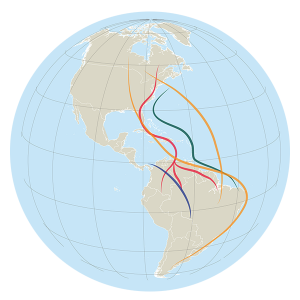Home Sweet Home: A Place for Birds and People

These birds face many threats during migration including loss of habitat, hunting, predation, climate change, and human disturbance that keeps them from the food they need to survive
All along the Atlantic coast, people love going to the beach. The sun, the surf, and the memories we create with our friends and families make the beach a special place. We fish, play, fly kites, walk our dogs, and relax while some of our most imperiled wildlife attempt to feed, rest, and raise their young nearby. For shorebirds like Piping Plover and Red Knot, and seabirds like the Roseate Tern, the beach is ‘home sweet home.’ Every year, as we flock to our favorite beach destination for sun and fun, shorebirds and seabirds return from their wintering areas in the Caribbean and South America to eat, rest, mate, and raise their young on the beach. These birds face many threats during migration including loss of habitat, hunting, predation, climate change, and human disturbance that keeps them from the food they need to survive
The Atlantic Flyway Shorebird Initiative is a collaboration of governments, non-governmental organizations, foundations, academics, scientists, and land managers all collaborating to help reduce threats to shorebirds and ultimately increase shorebird populations that have seen steep declines over the last several decades. We need your help to reduce human disturbance to beach birds! Take a look at the information below to understand why the beach is vital to birds and what you can do to protect their feeding, resting and nesting areas.
Birds Eat Here
While people can eat anytime of day, beach birds have a limited time to eat as the tide falls and reveals food along the shore and mud flats. When we disturb feeding birds, we drive them away from what they need to survive – food and a place to rest. Imagine if you were hungry and tired, and forces beyond your control kept you away from food all day, and no place felt safe to rest.
Long Distance Travelers
People and wildlife can share the beach! Just as you are coming here to relax, many birds stop at this beach to rest and refuel during migration as they fly between nesting areas in the arctic and wintering areas in South America. Watch for flocks of sleeping or resting birds and keep your distance so that you can both leave here relaxed and well-rested. Check out this cool infographic that shows the long migration journey of the Red Knot.
Birds Have Babies Here
Some birds, like the Piping Plover, can only raise their chicks on the beach. With growing demands on our beaches there are fewer places for them to nest. When they do, their nests and chicks are camouflaged and hard to see, so they are protected with signs and rope fencing. Protecting nesting areas also benefits sea turtles, terns, American Oystercatchers, and Black Skimmers, among other animals.
Dogs and People Can Frighten Birds
Even good dogs and responsible people can frighten beach birds. ALL dogs are seen as predators and these beach birds panic when a dog or person approaches their nest or chicks. Every dog is perceived as a threat, no matter its size or age. Dogs and people can cause beach birds to leave their eggs, stop feeding, and waste precious time and energy on distraction displays.

